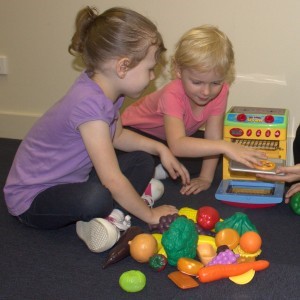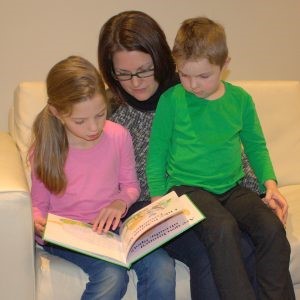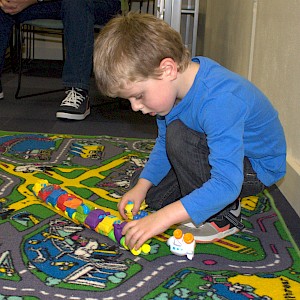The evaluation of visual perception determines whether the child is able to correctly interpret and react to sensory information that is perceived through their eyes (what s/he sees). Correct visual processing forms an important foundation for later skills such as reading, copying, writing, visual attention, concentration and word building abilities.
Various visual perceptual skills include:
- Visual figure-ground: The ability to see specific figures even when they are hidden in confusing and complex backgrounds, to perceive a picture or object as a whole, while also being able to isolate detail for example when reading.
- Visual form constancy: The ability to match two figures that vary on one or more discriminating features for example size, position or shade. This is important for reading.
- Position in space: The ability to perceive the spatial orientation of an object, letter or number, e.g. b/d/p. This is important for writing.
- Visual spatial relations: The ability to perceive the relationship between objects, symbols, letters and numbers with regards to each other and space, e.g. the spacing of letters and words in relation to each other in a sentence. This is important for writing.
- Visual discrimination: The ability to visually notice similarities and differences between objects, pictures, symbols, letters or words. This is important for spelling and reading.
- Visual memory: The ability to remember objects, numbers or words. Visual memory is important for all learning such as following complex instructions or remembering new spelling words.
- Visual sequential memory: The ability to remember objects, numbers or words in sequence. It is important for all learning or copying long sentences from the white board.
- Visual closure: The ability to visually complete a picture, shape, number or word. This is important for spelling.
- Visual analysis and synthesis: The ability to recognise loose parts as part of a whole. This is important for building puzzles and later word building.
- Visual-motor integration: The ability to copy symbols, numbers and letters. Visual-motor integration is important for handwriting and copying.
All of these skills need to develop on a:
- Body level: This is the ability to identify the top and bottom / left and right on your own body, to identify the orientation of your body in space and its in relation to other objects (e.g. can I squeeze my body through a small hole) and the ability to identify bigger and smaller body parts on your own body. For example with visual figure-ground. On a body level, finding my belly-button on my own body. Finding a freckle on my leg/arm.
- Three-dimensional level: Playing with objects and toys, which are three-dimensional. For example with visual figure-ground. Finding the red car in the toy box, finding the butter in the fridge.
- Two-dimensional level: On paper level. For example with visual figure-ground, finding “Wally” in the “Where’s Wally” book, completing mazes or identifying overlapping pictures or shapes.
- School related level: Related to schoolwork. For example with visual figure-ground; Reading as the child needs to find and identify one letter of word at a time and not loose his place in the book. Therefore, when a child struggles with reading, we need to investigate whether he struggles with visual figure-ground on a body level, three dimensional level or on a two dimensional level, BEFORE we start to work on his reading. Or in the case of a younger child, if he struggles to find his red car in the toy box, it indicates that his visual figure-ground has not developed sufficiently and we need to work on it, to prevent later problems with reading.

VISUAL PERCEPTUAL ACTIVITY IDEAS
Games to play:
- Building obstacle courses in the home or outside in play area for your child. Reinforce concepts such as over, under, inside, up, down etc (Visual spatial relations on a body level).
- While driving in the car, or waiting in the waiting room at doctor’s office, point to different objects in the room and identify the shape, e.g. the door is a rectangle; the chair seat is a square etc. (Visual form constancy)
- Hide objects in the garden, in a box full of beans, rice, birdseed such as puzzle pieces, Lego pieces etc. (Visual figure-ground)
- Play “I spy with my little eye” game in the car, while waiting somewhere (Visual figure-ground)
- Give your child chores e.g. find all the socks in the washing basket or find all the red t-shirts in the washing basket. (Visual figure-ground).
- Play “Simon says” games with your child, he must copy your body posture (Position in space and spatial relations)
Possible games to purchase:
- Busy colorful books with lots of picture, ask “Can you see the ___” and the child must find it. (Visual figure-ground)
- Eye-spy games (Visual figure-ground)
- Texture rubbings (Visual form constancy)
- Construction games with nuts and bolts (Visual Spatial relations)
- Lego (Visual Spatial relations)
- Transformers (Visual Spatial relations)
- Same-different game (Position in space and visual spatial relations)
- Busy buttons (Visual Spatial relations)
- Peg boards (Visual Spatial relations)
- Brainy blocks (Visual Spatial relations)
- Logi-shapes (Visual Spatial relations)
- Designer shapes (Visual Spatial relations)
- Playdough and cookie cutters, use it do make a variety of shapes etc, you build something and your child can copy you, practice letter land. (Visual Spatial relations)
- Tricky fingers (Visual Spatial relations)
- Any card game or playing with bugs or animals where the child can sort and match cards or objects, e.g. all the spiders in one box, all the butterflies in another, etc. (Visual discrimination)
- Animal match cards, monster memory (any memory card game) (Visual memory)
- Lacing and beading (Visual memory or visual sequential memory)
- Puzzles (Analysis and synthesis)
If you are concerned about your child's visual perception an occupational therapist is the person to see for advice. Occupational therapist can assess your child's skills and advise you on what to do to help your child's development www.talkingmatters.com.au
Blog written by Janine Franz, Senior Occupational Therapist
Related Blog Posts
If you liked this post you may also like:
Social skills resources
Reaching your P-OT-ential - Celebrating OT week
Celebrate OT!
How to be school ready



